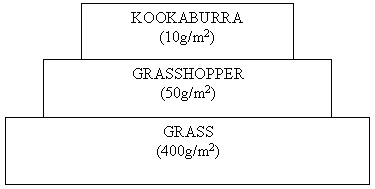
- Food Chain - A food chain is the series of organisms showing feeding relationships. A food chain almost always begins with a green plant (producer) which is eaten by an animal (consumer). The arrow means 'is eaten by', and shows the flow of matter and energy along the food chain. There are no decomposers in a food chain.
- Example of a Food Chain
Grass(Producer) ![]() Grasshopper(1st order Consumer)
Grasshopper(1st order Consumer) ![]() Kookaburra(2nd order Consumer)
Kookaburra(2nd order Consumer)
- Producer - usually a green plant that produces its own food by photosynthesis
- First-order Consumer - the organism that eats the producer
- Second-order Consumer - the organism that eats or derives nutrients from the first-order consumer
- Herbivore - a plant eater
- Carnivore - an organism that obtains nutrients from the blood or flesh of an animal
- Omnivore - an organism which eats both plant and animal matter
- Scavenger - an consumer that eats dead animals (e.g. crab)
- Detritivore - a consumer that obtains its nutrients from detritus
- Decomposer - an organism such as bacteria and fungi that breaks down dead organisms and their wastes
- Trophic Level - A trophic level is each level in a food chain. Matter is always 'lost' as heat energy at each trophic level.
- Basal Energy Requirement (B.E.R.) - the amount of energy used by an organism's body just to keep alive, when no food is being digested and no muscular work is being done
- Food Web - a network of interrelated food chains in a given area


- Loss of Matter and Energy - At each trophic level along a food chain, there is always a 'loss' of matter and energy in the forms of waste (e.g. carbon dioxide, faeces), and heat and kinetic energy (e.g. constant body temperature of mammals, the energy used to move). Up to 90% of matter and energy can be 'lost' at each level.
- Biomass - the total dry weight of the organisms in a trophic level
- Biomass Pyramid - a diagram showing the biomass at each trophic level of a food chain

BIOLOGICAL MAGNIFICATION
- Some chemicals that are taken in from the environment by plants, or consumed by animals, cannot be excreted by organisms. They accumulate in the body by the organisms, sometimes up to toxic levels. The more organisms there are in a food chain, the greater is the accumulation in the higher order consumers. Such chemicals include the pesticide DDT, and heavy metals such as mercury.
BIOLOGICAL CONTROL
- Pests - Pests may be plant or animal. They usually are introduced from overseas. Because of both their ability to survive and reproduce successfully in the Australian habitat, and their lack of predators or parasites, they reach pest population numbers, competing with the native flora and fauna.
- Biological Control of the populations of pest plants and animals is accomplished by non- chemical means involving predation, parasitism, or interruption to reproduction. Biological control is usually specific to a particular pest organism.
- Successful Biological Control Experiment Examples
- Prickly Pear Cactus - This introduced species was a pest throughout cattle farms in Queensland. The introduction of the Cactoblastis Moth reduced its numbers through consumption.
- European Rabbit - Rabbits arrived in Australia in 1788 and reproduced rapidly. The Myxoma Virus was developed in the 1900's to spread by direct contact and cause death.
- Unsuccessful Biological Control Experiment Examples
Cane Toad - Cane toads were originally introduced to sugar cane fields to reduce the numbers of cane beetles destroying sugar cane. However, cane toads did not eat cane beetles, instead reproducing rapidly themselves and causing death to native wildlife which ate them. No successful predators exist in Australia.

- Law of Conservation of Matter
Matter cannot be created nor destroyed in any chemical reaction. It can only be transformed from one form to another.
- Cycle - A cycle shows the reusing of certain elements and compounds (e.g. water, carbon, oxygen, nitrogen, phosphorus) in different forms in ecosystems.
WATER CYCLE
- The sun provides the heat energy required for the cycle to continue.
- The oceans and rivers are the main reservoirs of water.
- Evaporation - Water evaporates into the atmosphere.
- Condensation - Water condenses into droplets in the clouds.
- Precipitation - As the water droplets in clouds enlarge, water falls to earth in the form of rain, snow or hail.
- Transpiration - Water is lost through the leaves of plants ('trees perspiring').
CARBON AND OXYGEN CYCLES
- Carbon occurs in all living organisms in the forms of carbon dioxide, carbohydrates (sugars and starches), proteins and fats.
- Oxygen occurs in all living organisms in the forms of oxygen gas, water, carbon dioxide, carbohydrates, proteins and fats.
- Photosynthesis - Photosynthesis is the process used by plants containing chlorophyll to utilise sunlight, carbon dioxide and water to form sugar (as glucose) and oxygen.
Carbon Dioxide + Water ![]() Glucose Sugar + Oxygen
Glucose Sugar + Oxygen
CO2 + H2O ![]() C6H12O6 + O2
C6H12O6 + O2
- Respiration - Respiration is the process that most living organisms (including animals, plants, fungi and micro-organisms) use to obtain energy from glucose sugar and oxygen. The wastes formed are carbon dioxide and water.
Glucose + Oxygen ![]() Carbon Dioxide + Water + Energy
Carbon Dioxide + Water + Energy
C6H12O6 + O2 ![]() CO2 + H2O + Energy
CO2 + H2O + Energy